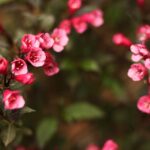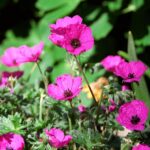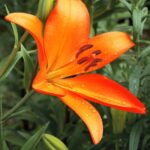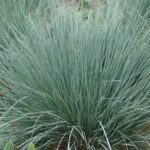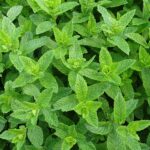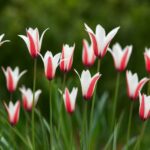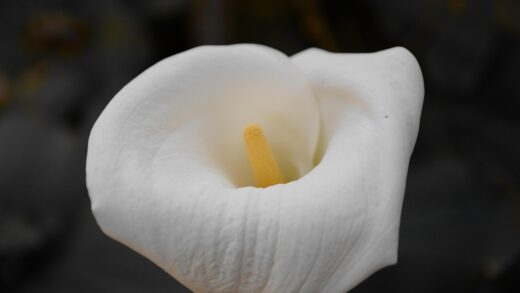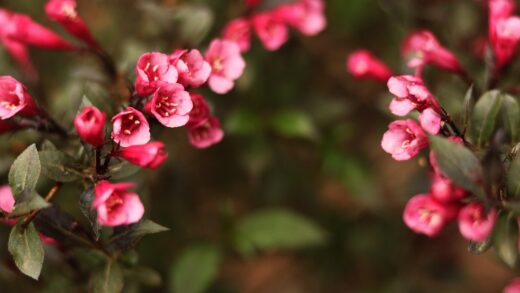While Brugmansia are robust and vigorous growers, they are not immune to the challenges posed by various pests and diseases. Their lush, tender foliage can be an attractive target for a number of common garden pests, and like any plant, they can be susceptible to fungal or viral diseases, particularly when growing conditions are less than ideal. Being able to identify these problems early and knowing how to effectively manage them is a critical skill for any gardener wishing to keep their angel’s trumpet healthy and beautiful. Proactive monitoring and swift, appropriate action are the keys to preventing minor issues from escalating into major threats that could compromise the plant’s vitality and its spectacular floral display.
Common sap-sucking pests
The most frequent adversaries of the Brugmansia are sap-sucking insects that feed on the plant’s fluids, weakening it and potentially transmitting diseases. Among the most common of these is the two-spotted spider mite. These tiny arachnids are difficult to see with the naked eye but their damage is distinctive. They typically colonize the undersides of leaves, causing a fine, yellowish stippling on the upper surface. In heavy infestations, you will notice fine webbing, particularly around the leaf axils and on the leaf undersides. Spider mites thrive in hot, dry conditions, and their populations can explode rapidly.
Aphids are another prevalent pest. These small, soft-bodied insects, which can be green, black, or yellow, tend to cluster on the tender new growth, flower buds, and the undersides of leaves. They feed on sap, which can cause new growth to become distorted and stunted. Aphids also excrete a sticky substance called honeydew, which can lead to the growth of sooty mould, a black fungus that, while not directly harmful, can interfere with photosynthesis. Their rapid reproduction rate means that a small number of aphids can quickly become a major infestation.
Whiteflies are small, moth-like insects that, like their name suggests, are white and will fly up in a cloud when a disturbed leaf is shaken. Both the adults and their nymph stages feed on plant sap, typically on the undersides of the leaves. Similar to aphids, they excrete honeydew, leading to the same issues with sooty mould. Heavy whitefly infestations can cause leaves to turn yellow, appear dry, and eventually fall off, significantly impacting the plant’s health and aesthetic appeal. They are particularly problematic in greenhouses and other sheltered environments.
Mealybugs present as small, white, cottony masses, often tucked into the crevices where leaves join the stem. These pests are covered in a waxy coating that protects them from predators and some pesticides. They drain the plant of its vital fluids, leading to reduced vigour, yellowing leaves, and premature leaf drop. Like other sap-feeders, they also produce honeydew, which encourages the growth of sooty mould. Their habit of hiding in protected areas of the plant can make them particularly difficult to control once established.
More articles on this topic
Chewing pests and other insects
While sap-suckers are the most common issue, Brugmansia can also be targeted by pests with chewing mouthparts. Various types of caterpillars, including the tomato hornworm, can cause significant damage in a very short amount of time. These large caterpillars are voracious eaters and can defoliate entire branches of a Brugmansia seemingly overnight. They are often well-camouflaged and can be difficult to spot despite their size. The primary evidence of their presence is large, ragged holes in the leaves or entire leaves being consumed.
Snails and slugs can also be a problem, particularly for young plants or those grown in damp, shady conditions. They are nocturnal feeders and will chew irregular holes in the leaves, often leaving a tell-tale slime trail behind them. While they may not cause the rapid devastation of a hornworm infestation, their persistent feeding can leave the plant looking tattered and unhealthy. They tend to hide during the day in cool, moist places, such as under the rim of pots or in dense ground cover.
Although less common, grasshoppers and certain types of beetles may also occasionally feed on Brugmansia leaves. The damage they cause is typically in the form of chewed leaf margins or holes within the leaf blade. While a minor amount of chewing from these insects is usually just cosmetic and does not pose a serious threat to a large, healthy plant, a significant population can cause considerable damage and should be managed to protect the plant’s foliage.
It is important to regularly inspect your plants for signs of these chewing pests. For caterpillars like the hornworm, the most effective control method is often to simply hand-pick them off the plant and dispose of them. For snails and slugs, using baits, traps, or creating barriers with materials like crushed eggshells or copper tape can be effective. A healthy garden ecosystem with natural predators like birds and beneficial insects will also help to keep populations of these chewing pests in check.
More articles on this topic
Fungal and bacterial diseases
One of the most serious threats to a Brugmansia is root rot, a fungal disease caused by pathogens that thrive in overly wet, poorly aerated soil. The symptoms of root rot can be deceptive, often starting with the wilting and yellowing of leaves, which might be mistaken for underwatering. However, if the soil is consistently soggy, the roots are effectively drowning and beginning to decay. This prevents the plant from absorbing any water or nutrients, leading to a rapid decline in health. Good drainage and careful watering are the only effective preventative measures.
Fungal wilts, such as Fusarium wilt and Verticillium wilt, are soil-borne diseases that can be devastating. The fungi enter the plant through the root system and colonize the vascular tissues, blocking the transport of water and nutrients throughout the plant. This leads to a sudden and often dramatic wilting of one or more branches, which typically does not recover even with watering. There are no chemical cures for these diseases, and they can persist in the soil for years. Using sterile potting mix for container plants and practicing good garden hygiene are the best defences.
Powdery mildew is another common fungal issue that appears as a white, powdery coating on the surface of the leaves. While it is generally not fatal, it is unsightly and can interfere with photosynthesis, weakening the plant over time. It tends to be most prevalent in conditions of high humidity and poor air circulation. Improving air movement around the plant by proper spacing and selective pruning can help to prevent its development. Applications of horticultural oil or specific fungicides can be used to treat existing infections.
Bacterial diseases are less common but can cause issues such as leaf spots or stem cankers. These are often opportunistic, taking hold when the plant is stressed or has been physically damaged. Prevention is key and involves avoiding overhead watering that leaves foliage wet for extended periods, ensuring good air circulation, and handling the plant carefully to prevent wounds that can serve as entry points for bacteria. Any infected plant material should be promptly pruned and disposed of to prevent the spread of the disease.
Viral infections
Viruses can also infect Brugmansia, and once a plant is infected, there is no cure. The most well-known is the Tobacco Mosaic Virus (TMV), which can affect a wide range of plants in the Solanaceae family. The primary symptom is a mosaic-like pattern of light green or yellow patches on the leaves, which can sometimes be accompanied by leaf distortion or curling. While the virus rarely kills the plant, it can reduce its overall vigour and diminish its aesthetic appeal.
Viruses are typically transmitted from one plant to another by sap-sucking insects like aphids, or mechanically on contaminated tools or hands. Therefore, the most effective way to manage viral diseases is through prevention. Controlling pest populations is of paramount importance, as this breaks the primary vector of transmission. Disinfecting pruning tools with a bleach solution or alcohol between cutting different plants is also a crucial practice to prevent the mechanical spread of viral pathogens.
If a plant is suspected of having a viral infection, it should ideally be isolated from other susceptible plants to prevent its spread. Because there is no cure, the decision must be made whether to live with the affected plant or to remove and destroy it to protect the rest of the garden. Propagating from a virus-infected plant is not recommended, as the cuttings will also carry the virus, perpetuating the problem in the new plants.
Ultimately, a healthy, thriving plant is the best defence against all types of diseases, including viruses. A Brugmansia that is properly watered, well-fed, and growing in good conditions will be much more resilient and better able to withstand or tolerate potential infections. Good cultural practices are the foundation of disease management, minimizing the need for chemical interventions and promoting a healthy garden environment.
Integrated pest management strategies
An integrated pest management (IPM) approach is the most sustainable and effective way to deal with pests and diseases on Brugmansia. This strategy prioritizes prevention and uses the least toxic methods first. The foundation of IPM is regular monitoring. Inspect your plants closely at least once a week, paying special attention to the undersides of leaves and new growth, to catch any problems before they become established. Early detection makes control significantly easier.
Cultural controls are the first line of defence. This involves creating a healthy growing environment that discourages pests and diseases. Ensure good air circulation, water at the base of the plant to keep foliage dry, provide the correct nutrition, and remove any weeds or debris from around the plant that could harbour pests. A strong, healthy plant is inherently more resistant to attack. Promoting biodiversity in your garden by planting a variety of flowers can also attract beneficial insects like ladybugs, lacewings, and parasitic wasps, which are natural predators of many common pests.
If pests are detected, the next step is to use mechanical or physical controls. This can be as simple as spraying a strong jet of water from a hose to dislodge aphids and spider mites, or hand-picking larger pests like caterpillars. For flying insects like whiteflies, yellow sticky traps can be used to monitor and reduce their numbers. These methods are non-toxic and can be very effective for managing low-level infestations.
If cultural and mechanical controls are not sufficient, the next level of intervention involves using biological or biorational pesticides. Insecticidal soaps and horticultural oils are excellent options for controlling soft-bodied insects like aphids, mites, and whiteflies. These products work by physical means (suffocating the pest) and have low toxicity to beneficial insects and humans. Neem oil is another valuable tool, acting as a repellent, growth regulator, and anti-feedant. Only as a last resort should broader-spectrum chemical pesticides be considered, as they can harm beneficial insects and disrupt the garden’s natural balance.








